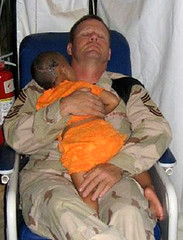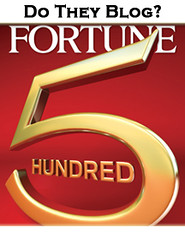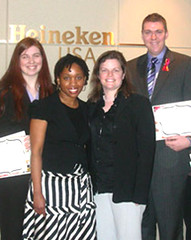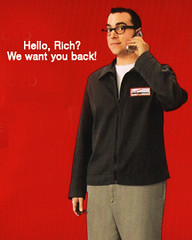Sometimes a single photo can lend even more to a story, which is why Bokjae (a name given to him by his Korean business contacts) included this one with his post as part of a social awareness campaign organized by BlogCatalog. The campaign asked bloggers from around the world to perform an act of kindness and share a post, picture, or video about it.
Bokjae chose the picture of John Gebhardt comforting a young girl. She was the sole survivor after her family was executed by insurgents in Iraq. Here, she is still recovering from a gunshot wound to the head.
“In all honesty, we believe John Gebhardt is the real winner because he is one who cared enough to do what he did,” says Bokjae, who originally learned about the story from a friend. “He is the real hero and it would be nice to reference John and his wife Mindy.”
Absolutely. According to the story, the nurses said Gebhardt was the only one who could calm the girl down. So he took it upon himself to hold her every night until she was closer to recovery. It’s amazing story, one that Bokjae says “it touches our hearts and its more than kindness, it’s Love of God who works in willing vessels!”
Although Bokjae, a retired telecommunications manager and qualified electronics specialist, isn’t quick to recognize it, the same can be said about him. He is a full-time caregiver to his wife, who is a stroke survivor.
“At the encouragement of a friend, we started our blog to share our experience through the process of stroke recovery from a caregiver's and a survivor's point of view,” says Bokjae. “One thing we have learned is that there are many kindhearted people in this world who really care. It’s very encouraging.”
Although being homebound, Bokjae is no stranger to service. After retiring, he and his wife became very involved in their local church and several organizations, helping orphans, seniors, and people enrolled in drug rehabilitation programs.
It’s not uncommon in Malaysia, he said. Everyone gives generously to worthy causes, including the corporate sector.
“Malaysians are a caring lot!” explains Bokjae, sharing his enthusiasm for his country. “Malaysian bloggers are no different from those around the world, except for the nuances in expression and Malaysian way of using English!”
In fact, since he first started blogging, he continues to be impressed with the friendships he has made. Blogging, he says, helps break down international boundaries, enhances tolerance, and builds understanding between cultures.
These are also among the reasons that Bokjae decided to participate in Bloggers Unite. He said it was opportunity to contribute something positive to the world, never believing that the judges would select his post.
They did. As one good deed deserves another, he will receive a full page ad in Blogger & Podcaster magazine, an iPod Touch donated by BlogCatalog, and admission to the next BlogWorld conference.
Congratulations again, Bokjae. And on behalf of the judges, thank you for sharing this amazing story as well as your own. It makes us look forward to sharing five more Acts of Kindness stories in the weeks ahead.

Bokjae chose the picture of John Gebhardt comforting a young girl. She was the sole survivor after her family was executed by insurgents in Iraq. Here, she is still recovering from a gunshot wound to the head.
“In all honesty, we believe John Gebhardt is the real winner because he is one who cared enough to do what he did,” says Bokjae, who originally learned about the story from a friend. “He is the real hero and it would be nice to reference John and his wife Mindy.”
Absolutely. According to the story, the nurses said Gebhardt was the only one who could calm the girl down. So he took it upon himself to hold her every night until she was closer to recovery. It’s amazing story, one that Bokjae says “it touches our hearts and its more than kindness, it’s Love of God who works in willing vessels!”
Although Bokjae, a retired telecommunications manager and qualified electronics specialist, isn’t quick to recognize it, the same can be said about him. He is a full-time caregiver to his wife, who is a stroke survivor.
“At the encouragement of a friend, we started our blog to share our experience through the process of stroke recovery from a caregiver's and a survivor's point of view,” says Bokjae. “One thing we have learned is that there are many kindhearted people in this world who really care. It’s very encouraging.”
Although being homebound, Bokjae is no stranger to service. After retiring, he and his wife became very involved in their local church and several organizations, helping orphans, seniors, and people enrolled in drug rehabilitation programs.
It’s not uncommon in Malaysia, he said. Everyone gives generously to worthy causes, including the corporate sector.
“Malaysians are a caring lot!” explains Bokjae, sharing his enthusiasm for his country. “Malaysian bloggers are no different from those around the world, except for the nuances in expression and Malaysian way of using English!”
In fact, since he first started blogging, he continues to be impressed with the friendships he has made. Blogging, he says, helps break down international boundaries, enhances tolerance, and builds understanding between cultures.
These are also among the reasons that Bokjae decided to participate in Bloggers Unite. He said it was opportunity to contribute something positive to the world, never believing that the judges would select his post.
They did. As one good deed deserves another, he will receive a full page ad in Blogger & Podcaster magazine, an iPod Touch donated by BlogCatalog, and admission to the next BlogWorld conference.
Congratulations again, Bokjae. And on behalf of the judges, thank you for sharing this amazing story as well as your own. It makes us look forward to sharing five more Acts of Kindness stories in the weeks ahead.






















